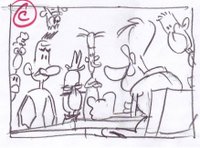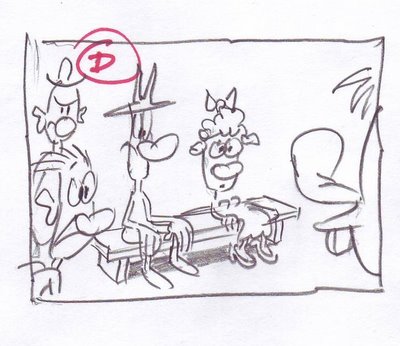Carl Reiner (above, left) was indisputably one of the funniest people ever to work in television. The best sketches he did with Sid Caesar may never have been matched. In view of that it's hard to account for why his own sitcom pilot, "Head of the Family" was so...so not happening.
I don't mean it was conceptually flawed. The germ of something valuable was there right from the start, and the show succeeded beyond expectation when it was reworked as "The Dick Van Dyke Show." I just wonder how it could have come about that a talented guy like Carl could have made so many mistakes at the outset.
The answer I'm going to give is almost certainly wrong, but for the purpose of this blog I'll assume that Carl crashed because he was a victim of bad storyboarding.
Here's (above) the intro to Carl's show. I'll assume it was done by an evil storyboarder who was hell-bent on sabotage.
The boarder has Carl dash out of his house and into his car. The music is generic, wacky, suburban music. Being evil, the boarder makes his human star a tiny speck. In this shot the car and the mailbox appear to be the true heroes of the show.
On a reverse angle (above) Carl pulls out of the driveway. You can't really see him. Geez, everything in this shot is light grey.
Above, the light grey car disappears into the light grey morass.
Now it's (above) the grey city's show. Carl doesn't stand out very well.
When he comes up to camera (above) he's covered by other people.
At last (above) we finally get to see our star. He enters his light grey office...
...and ceremoniously gives his hat to one of his writers. I forgot to say that Carl plays the role of a story editor for a TV show. This is where he works.
The title comes on and it's about a family, except we haven't seen a family yet. I'll add that Carl looks a little smug and unfriendly here.
He (above) removes the legs of one of his writers from his desk...
...then he takes his coat off while his credit comes on. Too late Carl is seen to be wearing dark clothes so that he he stands out from the grey. Fade out/fade in to...
...to his home (above) where we see his wife preparing food. Er, actually what we see first is the distant room behind her. The storyboarder made all the perspective lines point to it. Carl's wife is wearing...what else?...light grey.
The titles go on with his wife and son both getting a credit, but I'll end the intro here and switch to the reworked version of Carl's show (below), the later one that starred Dick Van Dyke. See what you think of it.
In the reworked show the title quickly fades on and we get a moment to read it. This intro is all indoors on a beautifully lit set. I presume the evil storyboard man has been killed and replaced with a good storyboard man.
Then the star comes in.
He's met by his wife and son. Since they seem likable, and they like Dick, we assume that Dick Van Dyke must be likable, too.
Dick's wife points to their guests...
...and that motivates a cut to a wider shot showing Dick's writer friends. Notice the perspective lines point to Dick.
Dick walks towards them and does a broad, funny trip over the ottoman.
We dolly in as everyone helps him up.
Dick comes up smiling. He probably tripped on purpose as a gag. In other words, he liked his friends enough to play a little prank on them. The good storyboarder has twice showed us that Dick is a funny, nice guy who's loved by his friends. Fade out. This is the end of the intro.
An interesting comparison, eh?
Carl stayed on as executive producer and the real life story editor of the show. On the advice of Danny Thomas and Sheldon Leonard it was shot at Desilu, which had the best TV facilities of its day.
So, was Carl an idiot for goofing up his first pilot? No, not at all. The later one works much better but who's to say that we wouldn't have made the same mistake in his place?
Carl's original intro understandably tried to drive home the point that the star was a family man who commuted every day to a glamour job in the big city. The later intro took a different tack and tried to make the point that the star was a funny, likable guy who the audience would probably like to spend time with. The latter point turned out to be the right way to go.




































